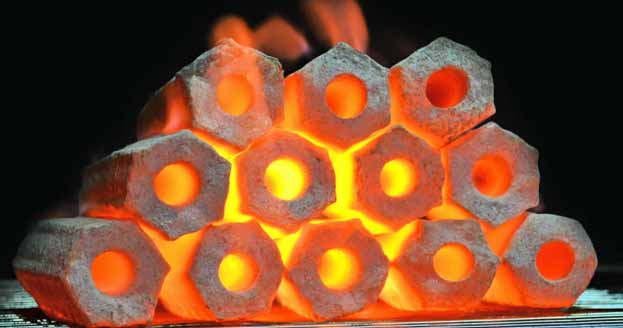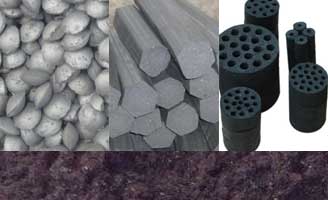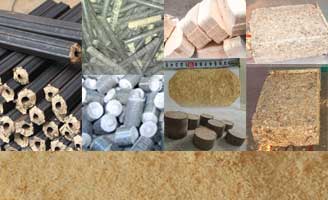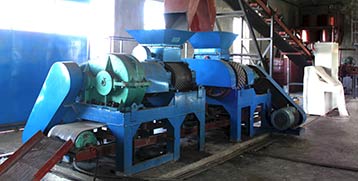Briquette calorific value data for biomass, sawdust, coal, charcoal
What is calorific value
The technology of taking briquettes as a kind of fuel has been widely used in many countries for both domestic and industrial purposes.
Briquette technology, as an important recycling system for the agricultural and industrial waste, has always contributed to offset forest and fossil fuels, bio-residue management problems and reduce toxic emissions from incomplete carbonization besides energy production development.
Common types of briquette now used are biomass. coal and charcoal, etc.
An important characteristic of the fuel briquette is its calorific value, according to the Dictionary of Mechanical Engineering (2014), the calorific value of a fuel (or heat of combustion or heating value or heat value) is defined as “the energy released per unit mass of fuel in complete combustion with oxygen.” Briefly for shortness, that is, the amount of energy (per kg) it exudes during combustion.
The calorific value determines the briquette efficient carbonization and heat value.
Although briquettes, as with most solid fuels, are priced by mass or volume and ease of handling, market forces set the price of each fuel according to its energy content.
Thus, the calorific value can be used to evaluate the competitiveness of a processed biomass fuel in a given market situation. The production cost of briquettes is, however, independent of their calorific values.
Moisture
Water and minerals in briquettes are non-combustible. During briquette combustion, the combustible materials are oxidized by oxygen, resulting in the release of thermal energy. Energy is required to heat up the water up to its boiling temperature and to vaporize it.
The calorific value of fuel rapidly reduces with increasing moisture content, which is unfavorable for the plant which uses biomass as a fuel material.
Chart 1: Effect of moisture on calorific value (kJ/kg)
| Moisture (%) | 5 | 8 | 11 | 15 | 20 |
| Corn Straw | 15422 | 14661 | 14280 | 13330 | 12569 |
| Cotton Straw | 15945 | 15167 | 14773 | 13808 | 13021 |
| Wheat Straw | 15438 | 14681 | 14301 | 13355 | 12598 |
| Poplar Branch | 13995 | 13259 | 12912 | 12042 | 11347 |
| Masson Pine | 18372 | 17439 | 17050 | 15937 | 15054 |
| Birch | 16945 | 16125 | 15715 | 14686 | 13870 |
| Cow Dung | 15380 | 14585 | 14209 | 13263 | 11678 |
Material types
The calorific value of briquette is influenced by its elemental composition, particularly the carbon, hydrogen and oxygen contents. Different species of material have different elemental composition; hence they have different calorific values.
Such as wood, the wood briquette made from conifers (more resinous softwood species) have higher calorific values than deciduous trees (less resinous hardwood species).
Briquetting process does not add to the calorific value of the base biomass and other materials.
Nonetheless, to upgrade the specific heating value and combustibility of the briquette, certain additives (e.g. charcoal and coal in very fine form or about 10 to 20% char fines) could be employed in briquetting without impairing the quality.
Briquette burning characteristics also depend on feedstock type, compactness level and the mold used.
Calorific value chart
Higher heating value or gross calorific value measures the total amount of heat/energy that would be produced by combustion of a briquette fuel. However, part of this heat is locked up as latent heat of vaporization of any water in the fuel during combustion.
Meanwhile, the lower heating value or net calorific value excludes this latent heat. Thus, the lower heating value is the amount actually available from the combustion process for capture and use. The higher the moisture content of a fuel, the greater the difference between gross calorific value and net calorific value and the less total energy will be available.
Chart 2: Higher heating value examples
| kJ/kg | Kcal/kg | ash (%) | |
| Biomass | |||
| Maple | 19960 | 4771 | 1.35 |
| Pine | 22300 | 5330 | 1.31 |
| Pine Needle | 20120 | 4809 | 1.5 |
| Poplar | 20750 | 4959 | 0.65 |
| Fir | 19950 | 4768 | 0.25 |
| Oak | 19420 | 4642 | 1.52 |
| Peach Nucleus | 20820 | 4976 | 1.03 |
| Apricot | 20010 | 4783 | 1.63 |
| Corn Cob | 18770 | 4486 | 1.36 |
| Wheat Straw | 17510 | 4185 | 8.9 |
| Cotton Straw | 18260 | 4364 | 6.68 |
| Corn Cob | 17650 | 4219 | 5.58 |
| Bagasse | 17330 | 4142 | 11.27 |
| Rice Husk | 14890 | 3559 | 20.6 |
| Walnut Shell | 20180 | 4823 | 0.56 |
| Charcoal | |||
| Coconut Shell Char | 31210 | 7459 | 2.9 |
| Oak Char | 24670 | 5896 | 17.9 |
| Redwood Char | 28350 | 6776 | 2.3 |
| Casuarina Char | 27260 | 6515 | 13.24 |
| Eucalyptus Char | 26750 | 6393 | 10.45 |
| Coal | |||
| Lignite | 8000-15000 | 1912-3585 | 6-19 |
| Bituminous | 12000-20000 | 2868-4780 | 3.3-11.7 |
| Anthracite | 26000-33000 | 6214-7887 | 9.7-20.2 |
Chart 3: Lower hearing value examples
| Moisture (%) | kJ/kg | Kcal/kg | ash (%) | |
| Bagasse | 18 | 17000-18000 | 4063-4302 | 4 |
| Coconut Shell | 5-10 | 16700 | 3991 | 6 |
| Coffee Husk | 13 | 16700 | 3991 | 8-10 |
| Corn Straw | 5-6 | 17000-19000 | 4063-4541 | 8 |
| Corn Cob | 15 | 19300 | 4613 | 1-2 |
| Cotton Shell | 5-10 | 16700 | 3991 | 3 |
| Palm Fiber | 55 | 7000-8000 | 1673-1912 | 10 |
| Palm Shell | 55 | 7000-8000 | 1673-1912 | 5 |
| Poplar | 5-15 | 17000-19000 | 4063-4541 | 1.2 |
| Rice Husk | 9-11 | 13000-15000 | 3107-3585 | 15-20 |
| Rice Straw | 15-30 | 17000-18000 | 4063-4302 | 15-20 |
| Willow Branch | 8-15 | 18000-20000 | 4302-4780 | 6 |
| Wheat Straw | 7-15 | 17000-19000 | 4063-4541 | 8-9 |
| Willow | 12 | 17000-19000 | 4063-4541 | 1-5 |
Above charts data from Nrel, Penn State, Wikipedia, etc.
Calculation formula of calorific value
HHV (kJ/kg) =3.491C+1178.3H-103.4O-21.1A+100.5S-15.1N
HHV stands for higher heating value.
C, H, O, A, S stands for the mass fraction of carbon, hydrogen, oxygen, ash, sulfur and nitrogen.






